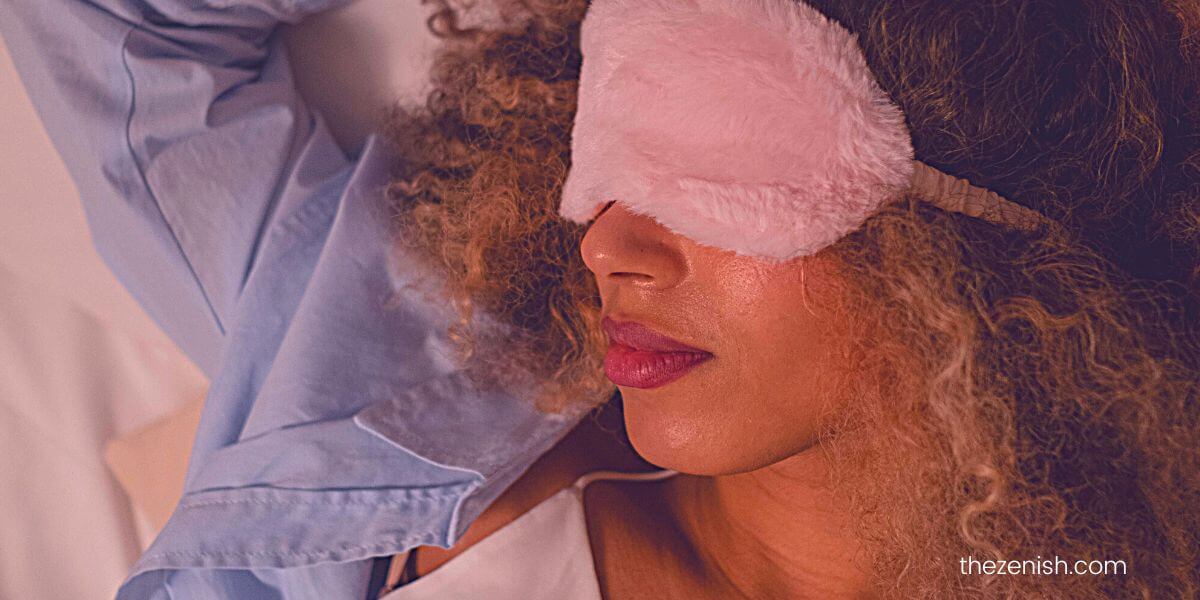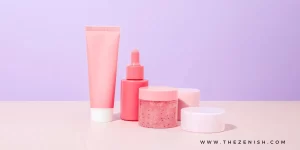Are you guilty of falling asleep with sunscreen on?
You’re not the only one.
Many people wonder whether it’s okay to sleep with sunscreen on, especially after a long day.
While some believe it’s harmless, others argue that it can do more harm than good.
So, what’s the truth?

| this post may contain affiliate links, which means if you purchase from one of these links, I may receive a small commission at no additional cost to you. |
Is it really ok to sleep with sunscreen on?
While it’s not ideal, you can technically sleep with sunscreen on.
However, it’s not recommended.
First of all, sunscreen is designed to protect your skin from the sun’s harmful UV rays.
At night, there’s no need for sun protection, as you’re not exposed to sunlight.
So wearing sunscreen wouldn’t provide any additional benefits to your skin.
Secondly, sleeping with sunscreen on can cause some skin issues.
Depending on what ingredients are in it and how thick it is, sunscreen can clog your pores, which can lead to breakouts and other skin problems.
Instead of wearing sunscreen to bed, try using a moisturizer or night cream.
These products are designed to hydrate and nourish your skin while you sleep and can help repair any damage that may have occurred during the day.
So, skip the sunscreen at night and let your skin breathe!
What happens if you sleep with sunscreen on?
Well, first of all, it’s important to note that sunscreen is designed to be worn during the day when you’re exposed to the sun’s harmful rays.
It’s not meant to be worn at night.
However, if you do happen to fall asleep with sunscreen on, it’s not the end of the world, but it’s not ideal either.
Leaving sunscreen on overnight can clog your pores and potentially lead to breakouts.
It can also cause irritation or allergic reactions in some people.
Plus, let’s be honest – it’s not the most comfortable thing to sleep in!
So, what should you do if you accidentally fall asleep with sunscreen on?
In the morning, wash your face thoroughly with a gentle cleanser to remove any residual sunscreen.
If you experience any irritation or breakouts, try using a soothing moisturizer or spot treatment to help calm your skin.
So while it’s not the end of the world if you sleep with sunscreen on, it’s best to avoid it if possible.
So, do your best to wash it off before going to bed.
How to remove sunscreen before bed
After a long day outside, it’s important to remove your sunscreen before bed to avoid clogged pores and potential breakouts.
Here are a few tips to help you remove your sunscreen effectively:
Use an oil-based cleanser
If you’re wearing water-resistant sunscreen, you may need to use an oil-based cleanser to effectively remove it.
Oil-based cleansers work by breaking down the oils in your sunscreen, making it easier to wash away.
Massage the cleanser into your skin for a few minutes to ensure that all the sunscreen is removed.
Double cleanse
After using the oil-based cleanser, follow up with a second cleanser to remove any remaining residue.
This will help ensure that your skin is completely clean before you go to bed.
Look for a gentle, water-based cleanser that’s formulated for your skin type.
Rinse with warm water
When you’re done waking your face, rinse with warm water to remove any remaining cleanser or sunscreen.
Be sure to use a clean washcloth or your hands to avoid transferring any bacteria to your skin.
What is sunscreen?
Sunscreen helps to protect your skin from the sun’s harmful UV rays.
It comes in various forms like lotions, creams, sprays, and gels, and works by absorbing or reflecting the UV rays, keeping them from entering your skin and causing damage.
There are two types of UV rays that can be harmful to your skin: UVA and UVB.
UVB rays cause sunburn, while UVA rays can cause long-term damage like premature aging and an increased risk of skin cancer.
That’s why it’s important to use a broad-spectrum sunscreen with a high Sun Protection Factor (SPF) to protect against both types of UV rays.
When shopping for sunscreen, look for active ingredients like zinc oxide, avobenzone, octisalate, and homosalate, which are commonly found in broad-spectrum sunscreens.
See also: The 7 Best La Roche Posay Sunscreen
If you have sensitive skin, you might want to look for sunscreen with titanium dioxide as an active ingredient.
To use sunscreen properly, apply it 15-30 minutes before sun exposure and reapply every two hours or immediately after swimming or sweating.
Remember, sunscreen is just one part of sun protection – make sure to wear protective clothing and seek shade when possible.
So, use sunscreen and stay safe out there!
How does sunscreen work?
A sunscreen is a crucial tool in protecting our skin from the sun’s harmful rays.
But how does it actually work?
Well, sunscreen works by either blocking or absorbing UV radiation.
UV radiation can cause skin damage and increase the risk of skin cancer, so it’s important to protect against it.
Sun protection factor
Sun protection factor (SPF) is a measure of how well a sunscreen can protect against UVB rays, which are the primary cause of sunburn and skin cancer.
The higher the SPF, the better the protection.
But here’s the thing – SPF only measures protection against UVB rays and not UVA rays, which can also cause skin damage.
That’s why it’s important to use a broad-spectrum sunscreen that protects against both types of rays.
Look for ingredients like zinc oxide, avobenzone, octisalate, and homosalate, which are effective at blocking both UVA and UVB rays.
Physical sunscreens, like those containing titanium dioxide or zinc oxide, work by reflecting UV radiation away from the skin.
Chemical sunscreens, on the other hand, absorb UV radiation before they can penetrate the skin.
To use sunscreen correctly, apply it to all exposed skin, including your face, neck, and ears.
The FDA recommends using at least SPF 30 and reapplying every two hours or after swimming or sweating.
So lather up and stay protected!
FAQs
What happens if I sleep with sunscreen on?
Leaving sunscreen on overnight can clog your pores and potentially lead to breakouts.
It can also cause irritation or allergic reactions in some people.
Plus, it’s not the most comfortable thing to sleep in!
How do I remove sunscreen before bed?
To remove sunscreen before bed, use a gentle cleanser that’s specifically designed to remove sunscreen, like micellar water or oil-based cleanser.
See also: Bye-bye sunscreen: Can micellar water remove sunscreen effectively?
Wet your skin with warm water, apply the cleanser, and massage it into your skin.
Rinse thoroughly with warm water and pat your skin dry.
What if I forget to remove my sunscreen before bed?
If you accidentally fall asleep with sunscreen on, don’t panic.
In the morning, wash your face thoroughly with a gentle cleanser to remove any residual sunscreen.
If you experience any irritation or breakouts, try using a soothing moisturizer or spot treatment to help calm your skin.
Can I wear sunscreen to bed if it’s part of my nighttime routine?
While it’s not necessary to wear sunscreen to bed, some skincare products do contain sunscreen.
If you’re using a product that contains sunscreen as part of your nighttime routine, (like a moisturizer with SPF that you use in the morning and night), it’s okay to leave it on.
Just make sure to follow the instructions on the product and use it as directed.
Remember, it’s best to avoid it if possible, but if you do happen to fall asleep with sunscreen on, don’t worry – just wash it off in the morning and you’ll be good to go!
Alternatives to sunscreen
Here are several alternatives you can try to protect your skin from harmful UV rays.
Protective clothing
One of the best ways to protect your skin from the sun is to wear protective clothing.
This includes long-sleeved shirts, pants, and hats. Look for clothing made from lightweight, breathable materials that provide UPF (Ultraviolet Protection Factor) of 50 or higher.
This will help to block out harmful UV rays and keep your skin safe.
Hats
Wearing a hat is another great way to protect your face and scalp from the sun.
Look for hats with wide brims that provide shade for your face and neck.
Baseball caps are not as effective, as they only protect the front of your face and leave your neck and ears exposed.
Sunglasses
Sunglasses aren’t just a fashion accessory – they also provide important protection for your eyes.
Look for sunglasses that provide 100% UV protection to block out harmful UV rays.
This will help to prevent damage to your eyes and reduce your risk of developing cataracts or other eye conditions.
Other tips
In addition to these alternatives, there are several other tips you can follow to protect your skin from the sun:
- Avoid going outside during peak sun hours (10 a.m. to 4 p.m.).
- Seek shade whenever possible.
- Use broad-spectrum sunscreen with an SPF of 30 or higher when you are going to be outside for an extended period of time.
- Reapply sunscreen every two hours, or more often if you are swimming or sweating.
- Wear protective clothing, hats, and sunglasses even on cloudy days, as UV rays can still penetrate through clouds.
By following these tips and alternatives, you can protect your skin from the harmful effects of the sun without having to sleep with sunscreen on.



